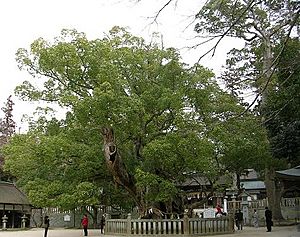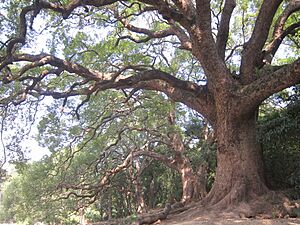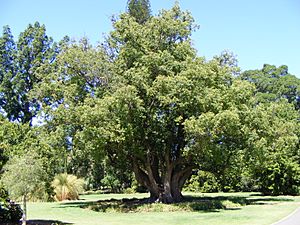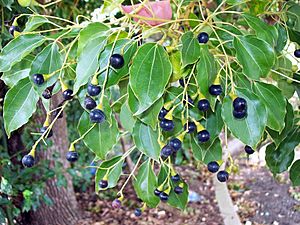Cinnamomum camphora facts for kids
Quick facts for kids Cinnamomum camphora |
|
|---|---|
 |
|
| An ancient camphor tree (estimated to be over 1,000 years old) in Japan | |
| Scientific classification | |
| Genus: |
Cinnamomum
|
| Species: |
camphora
|
The Cinnamomum camphora is a type of evergreen tree often called the camphor tree, camphorwood, or camphor laurel. It's known for its strong, fresh smell, especially when you crush its leaves.
Contents
What is the Camphor Tree?
The camphor tree originally comes from China (south of the Yangtze River), Taiwan, southern Japan, Korea, and Vietnam. Today, you can find it growing in many other countries too. These trees can grow quite tall, reaching about 20 to 30 meters (65 to 98 feet) high. In Japan, where it's called kusunoki, some camphor trees are incredibly old and huge. One famous tree, the Kamō no Ōkusu, has a trunk that is over 24 meters (79 feet) around!
Its leaves are shiny and waxy, and they smell strongly of camphor when you crush them. In spring, the tree gets bright green leaves and lots of small white flowers. Later, it grows clusters of black, berry-like fruit that are about 1 centimeter (0.4 inches) wide. The tree's light-colored bark is very rough and has vertical cracks.
How are Camphor Trees Used?
Camphor trees are grown for their wood and for a special substance called camphor. In Taiwan, making and shipping camphor was a very important business, especially when Japan ruled the island (1895–1945).
Camphor was used as a medicine. It was also a key ingredient for making smokeless gunpowder and a type of plastic called celluloid. Workers would set up simple factories in the mountains where the trees grew. They would chip the wood, then steam the chips. The steam would carry the camphor, which would then turn into a solid, waxy form inside a cooling box. This solid camphor was then collected and sent to government factories for more processing and sale. Camphor was one of the most profitable products controlled by the Japanese government at that time.
The wood of the camphor tree also naturally keeps insects away.
What is Camphor?

Camphor is a white, crystal-like substance that comes from the camphor tree. For hundreds of years, people have used camphor in many ways. It has been a culinary spice in food, a part of incense (which smells nice when burned), and a medicine. It's also well-known for being an insect repellent and can even kill fleas.
Different Types of Camphor Oil
All parts of the camphor tree contain natural, oily chemicals. The wood and leaves are often used to make essential oils. Interestingly, camphor laurel trees have six different natural versions, called chemotypes. These versions produce different main chemicals: camphor, linalool, 1,8-cineole, nerolidol, safrole, and borneol. In China, people who harvest the trees can tell the different types apart just by their smell! For example, the cineole type of camphor laurel is sometimes used to make fake "eucalyptus oil."
The type of chemicals a camphor tree produces often depends on where it grows. For instance, camphor trees from Taiwan and Japan usually have a lot of linalool (often 80-85%). In India and Sri Lanka, the type that produces a lot of camphor is more common. However, camphor trees grown in Madagascar often have a lot of 1,8-cineole (about 40-50%). The essential oil from these Madagascar trees is known as ravintsara.
Is the Camphor Tree an Invasive Species?


In some parts of the world, the camphor tree has become an invasive species. This means it grows too well and spreads quickly, harming the local environment.
In Australia
The camphor tree was brought to Australia in 1822. People planted it in gardens and public parks because it looked nice. But it has become a harmful noxious weed in Queensland and northern New South Wales, where the wet, subtropical climate is perfect for it.
While it grows quickly and creates hollows in its branches (which some animals use for homes), it causes problems for native plants. The leaves that fall from the camphor tree contain camphor, which can stop other plants from growing nearby. Also, birds love to eat the seeds, and when they fly and drop the seeds, the tree spreads very fast. Camphor trees can take over rainforests and pastures. They also compete with eucalyptus trees, which are the only food source for koalas.
In the United States
The camphor tree was brought to the contiguous United States around 1875. It has now spread naturally in parts of Alabama, California, Florida, Georgia, Hawaii, Louisiana, Mississippi, North Carolina, Texas, and South Carolina. In Florida, it has even been officially called a category I invasive species, meaning it causes serious harm to the environment.
What About Insect Pests?
In Australia, two native Lepidoptera (a group of insects that includes butterflies and moths) called the purple brown-eye and common red-eye have caterpillars that eat the camphor tree's leaves, even though it's not a native plant there.
Images for kids
See also
 In Spanish: Alcanforero para niños
In Spanish: Alcanforero para niños


